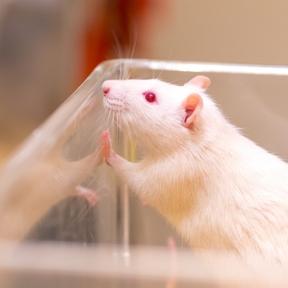Our immune system (or defense system) is complex, and it’s often thought that studying it requires the entire body of an animal. However, our immune system is so specific that an animal doesn’t provide valuable information about humans. Fortunately, more and more methods are being developed to mimic human immune functions. In this article, you’ll learn more!
How our immune system works
Our immune system is complex, but also spectacular. It acts as our defense mechanism against diseases. Did you know that your body defeats about seven viral infections and ten tumors every day?
We are protected by our immune system in various ways. Our skin and intestines form the first line of defense. These contain cells that create a protective barrier. If a virus or another disease does manage to enter your body, the second line of defense kicks in. This consists of different types of white blood cells found in the blood, tissue fluid, and lymph nodes. These cells are present in all organs, ready to intervene if necessary.
Why is research on our immune system necessary?
The immune system protects us from diseases. If something goes wrong with the immune system, it can have serious consequences:
- The immune system can overreact to harmless substances (like pollen), causing allergies.
- It can also turn against the body itself, leading to autoimmune diseases like rheumatoid arthritis.
Research on the immune system (immunology) is therefore crucial. By studying the immune system, scientists can develop better treatments for disorders and diseases. For example, in cancer, the immune system can be harnessed to destroy cancer cells, and research into the immune response to viruses helps us develop vaccines.

Why are animals used in this research?
The immune system is present throughout our body. Various organs, such as the skin, intestines, and lymph nodes, work together to protect us. Understanding how these organs are interconnected and how they collectively contribute to the functioning of our immune system is important.
To conduct thorough research, scientists aim to study this complex interaction of organs in the human immune system as a whole. In the absence of a better model, they currently use animals like mice and rats for this purpose.
Differences between humans and mice
However, even when researchers study an entire animal, it doesn’t yield the desired information. Our immune system is so specific that animals provide little valuable information for humans.
There are many (genetic) differences between the immune systems of mice and humans. As a result, animals respond differently to pathogens than humans, either because their immune system operates differently or because certain blood cells and/or antibodies are too different from those of humans.
Additionally, many pathogens are specific to humans and do not naturally cause disease in animals. Examples include the hepatitis B virus and HIV: these viruses cause illness only in humans, making it difficult to study their full disease course or immune response in animals.

Genetically modified mice
Because the immune system of laboratory animals is not the same as that of humans, researchers have developed special mice with a human immune system. These mice have been genetically modified. Although these mice have received human immune system cells, their bodies still do not resemble those of humans. Therefore, research on the immune system using animals does not translate well to humans.
Animal-free alternatives for immunology
But there are alternatives, and we’re further along than you might think. Worldwide, numerous researchers are working to develop human-specific research models for immunological studies.
Immune system-on-a-chip
Researchers at Harvard University in the United States developed an immune system-on-a-chip in 2022. One of these researchers is Abidemi Junaid, with whom we also collaborate. The researchers accidentally discovered that when they added different types of white blood cells to an organ-on-a-chip, these cells triggered an immune response just as they would in the human body.
The researchers have further developed the immune system-on-a-chip. They wanted to mimic and study the human immune system’s response to vaccines using the chip. They discovered that the immune cells in the chip reacted to the flu vaccine just as they would in the human body, namely by producing antibodies against the flu!
Vaccine development without laboratory animals
For the development of vaccines, such as COVID-19 vaccines, hundreds of thousands of laboratory animals were used, including mice and hamsters. The immune system-on-a-chip shows promising results for the future of vaccine development without animals! Researchers are also working on further developing this technique, for example, by integrating various components of the immune system into a multi-organ-on-a-chip.

LymphChip
The LymphChip project is a collaboration of no fewer than 21 different parties working together on an animal-free model for the human lymphatic system. The lymphatic system is essential for the proper functioning of our immune system: a disrupted lymphatic system can lead to chronic inflammation, autoimmune diseases, and even organ failure.
In the LymphChip project, a heart-on-a-chip, gut-on-a-chip, and skin-on-a-chip are being developed with integrated lymph nodes. Fun fact: we co-finance this project with €100,000!
Humane skin model for burn research
When someone suffers from burns, the body must work hard to repair the damaged skin. The immune system’s response to burns is crucial in preventing infections, to which burn patients are particularly vulnerable.
A lot of laboratory animals are used to study burn healing, but there are animal-free alternatives: such as artificial skin. Unfortunately, the functioning of our immune system is not yet (fully) incorporated into these models. This is particularly important for the healing of burns. In previous studies, scientists have already added some immune system cells to skin models. Patrick Mulder wants to further expand this with his research. He hopes to develop a skin model that can reliably test new treatments for burns.

Join our LinkedIn group
The Animal Free Gallery is your platform to share successes, exchange knowledge, and network with like-minded professionals and scientists. Together we can make strides towards innovations without animal testing. Join us and celebrate every development towards ethical and innovative research!

